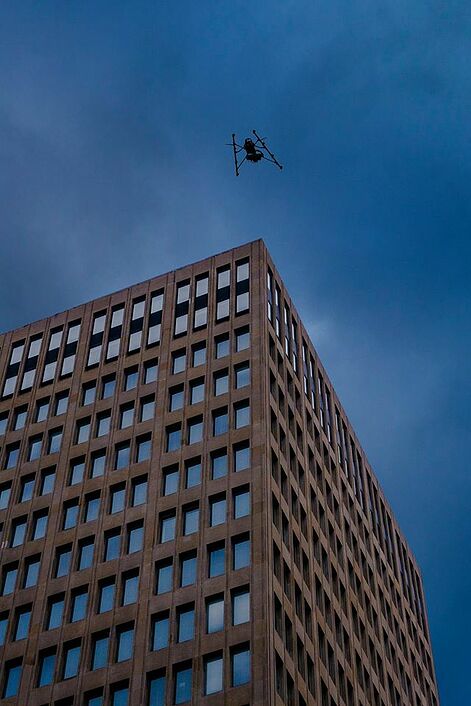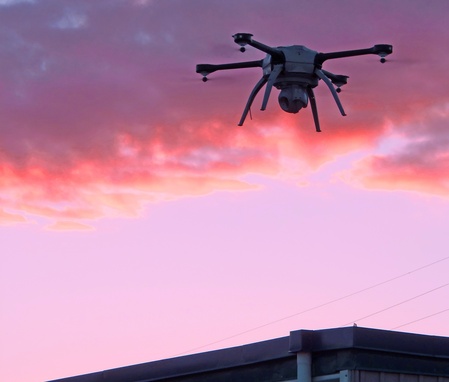Drones & Automation: How they Help Roofing Contractors
![]()
Drones and automation technologies are increasingly providing a cost-effective and faster means of gathering critical information from the roofs. Using other technologies such as analytics and artificial intelligence-enabled drone inspection software, the roofing companies are able to turn the information from drones into actionable data much faster than the traditional methods. This gives the contractors more time hence allowing them to provide better services to a larger customer base.
Generally, the drone roof inspections are useful to the contractors, insurance companies’ as well as solar installers. In addition to reducing the speed of inspections, they mitigate the safety risks and reduce insurance costs.
For roof contractors, the drones are helping them to perform quick and safer roof inspections, improve accuracy in their measurements and assessments, and hence create better estimates and proposals.
The UAV devices help to save time, money while reducing risks and improving the accuracy of the data gathering processes.
How do drones work in the roofing industry?
In a typical drone roof inspection, the device will fly above the building while capturing photos, videos, and thermal images if looking for insulation defects. It then transmits the images and video to the cloud or other online platforms where operators on the ground can access or use tools to analyze and generate reports.
The software tools enable the contractors to automatically analyze drone data and gain insights into the status of the roofs. This also allows them to obtain crucial data such as the roof dimensions, condition of the roof or roofing material and status. In addition, the analysis helps the contractors to identify if there are defects, their nature, and magnitude. Using the internet technologies, the contractors can even share the data between different stakeholders including the building owners since the reports are usually available in different and easy to understand formats for everyone.
Generally, the drones, analytics and software technologies ease the work of inspecting the rooftops for a wide range of applications. In particular, they help to perform the preliminary work for the contractors when designing, maintaining, repairing or replacing the roofs. These tasks are usually time-consuming in addition to being risky and costly when using traditional manual methods.
The output from inspection drones
The devices provide rich data sets with a lot of useful information. The data enables the contractor to accurately measure and make proper estimates of the length, area, volume, slope, and other rood parameters. Also, the drones enable the mapping of information and production of high-resolution 3D models which the professions can use to identify defects and damages.
Using software like BlueVu, pilots are able to create 3D structures as well as generate a wide range of reports and data in different formats. This makes it easier to share the information, export, import or integrate the data with other standard tools such as Google Earth, AutoCAD and more.

Benefits of using drones and automation
Roofing contractors can use a drone to inspect roofs and collect valuable data useful for making estimates, identifying defects, for maintenance recommendations and more. Benefits of using UAVs include;
Improved safety for workers, occupants and general public
The drones eliminate the need human workers to climb the building structures and walk on the roofs when taking measurements or looking for damages. They give workers the ability to inspect the roofs automatically from a safe distance.
Other than reducing the time it takes to set up and climb equipment, the UAV devices reduce risks such as falls from the equipment or from collapsing roofs, insect stings and more.
Advances in drone technology allow them to access even the very tight spaces hence enabling contractors to survey, inspect and take measurements from almost any type of a structure including complex roofs.
Also, the devices are suitable for carrying out preliminary investigations after a roof collapse, disaster or accident. By sending a drone to the rooftop, it can assess the damage and send the images to the operators. This enables the inspectors to determine the extent of damage as well as requirements for a human worker to climb.
Reduce inspection time
Planning and executing drone-based inspections take less time and effort compared to traditional manual methods. This gives contractors the ability to carry out inspections faster while using fewer resources. Consequently, the drones help in cutting the inspection times and costs hence enable the contractor to carry out more inspection projects and serve more customers.
Unlike the manual methods where workers require time and heavy climbing equipment, the drone inspection or survey is much faster, easier to plan and execute. All that an inspector or operator requires is the drone, and a few minutes to plan and map the flight. Once ready, it only requires as little as five minutes to launch the drone and inspect the roof. As such, it is possible to gather comprehensive rooftop data in about half an hour.
Usually, the traditional manual inspection methods require heavy equipment, time to set them up and climb. Since workers need to take precautions while at the rooftops, the inspection process is usually slow and may not be as accurate due to the inability to access difficult to reach as well as confined spaces. However, a drone overcomes all these challenges and is also faster, more accurate since it eliminates the human factor errors.
The increase in speed means that they are able to identify and address any urgent roof defect or impending failure. Resolving problems in good time prevents complete failures, further damage, and even accidents. So, this benefits the building owner, occupants, the general public and the contractor.
Enables contractors to automate the detection of damages
Automating the data collection process using drones helps the contractors to save time and costs of inspections, reduces risks to workers and people inside and near the buildings while obtaining better information.
Using automation and other software tools allows the contractors to analyze the data collected from the roofs, generate reports and present them in the correct formats. In particular, once the drones capture the images, the contractors can use other technologies such as 3D, artificial intelligence, analytics and other tools to analyze them and generate actionable reports.
Technologies such as machine learning have the ability to learn the unique characteristics of different types of damage. As such, as drones capture images of the roofs, AI and ML help to analyze and automatically identify and categorize the damages. Also, the drone-based inspections are repeatable, hence providing an opportunity to compare before and after images of a particular spot.
By getting more comprehensive data and analysis, the roofing contractors are able to make better and accurate estimates, find almost all existing and potential roof damage.
Better accuracy and improved speeds
Other than the ability to collect comprehensive data quickly, drone-based inspections are free of human errors and omissions. Another advantage of the drone is the ability to repeat inspections at exactly the same spot, angle and orientation. This is can be a challenge for human beings and especially if a different worker is performing the repeat job.
In addition, the drones with inbuilt GPS have the potential to take measurements with an almost 100 percent accuracy. This approach is much better than the other methods that rely on satellite imagery.
Generally, roofing contractors can use drones and other digital technologies to automate measurements, generation of estimates as well as damage detection activities. Using appropriate platforms and tools, the technologies can even generate reports that include the materials for the roofing project.
This increases the speed and accuracy of preparing proposals while minimizing the challenges contractors usually face with the manual methods. With such as an approach, the contractors are able to analyze more roofs, submit many proposals, gain customer’s trust and improve revenue.
Identify defects invisible to the human eye
Advances in sensors and drone technology enable easy access to the difficult to reach areas and acquiring vital information invisible to the human eye. With the appropriate sensors such as thermal imaging, corrosion, and gas leak detectors, drones can help the contractors to identify a wide range of issues.
Even when the human worker has the ability to identify a fault better, they may not have access to some confined spaces. This is especially so with complex roof designs.
Although not always better than humans, the drones are very good in supplementing the human worker and automation can completely eliminate the need for the workers on top of the roof for inspections.
Provide better services and gain trust and reputation
The drones enable the roofing contractors to provide better services, faster and efficiently. Usually, the devices provide the contractors with accurate estimates hence allow them to perform the jobs without deviating or changing the proposal. This improves customer satisfaction and trust.
Faster assessment for the rooftops makes it possible to create better proposals faster and also provide enough time to plan and carry out the work. Because the data is shareable, the contractor is also able to streamline the project planning, material acquisition, and other areas that ensure the success of the roofing installation. Further, the accurate data ensures that the material orders are adequate with no unnecessary shortages or excesses which may lead to delays or wastage respectively.
Conclusion
Drones and automation have the potential to ease the work of inspecting roofs in addition to reducing the time, cost and safety risks.
The technologies provide the contractors with the ability to automate data collection, processing and analysis, generating and sharing accurate estimates, sharing of reports and other activities. This helps to streamline a wide range of tasks and processes that the contractors require to inspect, analyze and create reports.
About Industrial SkyWorks
About Industrial Skyworks:
Industrial Skyworks (ISW) is a commercial, unmanned aerial system (UAS) and data management solutions company with offices in Houston and Toronto. Founded in 2012 by pilots with backgrounds and expertise in aircraft safety systems, risk management, and aeronautical sciences, ISW inspects buildings and oil and gas infrastructure using small Unmanned Aerial Systems (sUAS). They are the first company ever to receive FAA’s approval for night-time drone operations.
- Drones & Automation: How they Help Roofing Contractors – July 17, 2019
- The Top 8 Benefits of Drones on the Oil and Gas Job Site – July 12, 2019
- Top 3 Drone Applications in Oil and Gas Industry in 2020 – July 3, 2018
- Top 3 Drones for Industrial Inspections – May 28, 2018
- How Drones Improve Safety and Efficiency Across Industries – March 15, 2018

